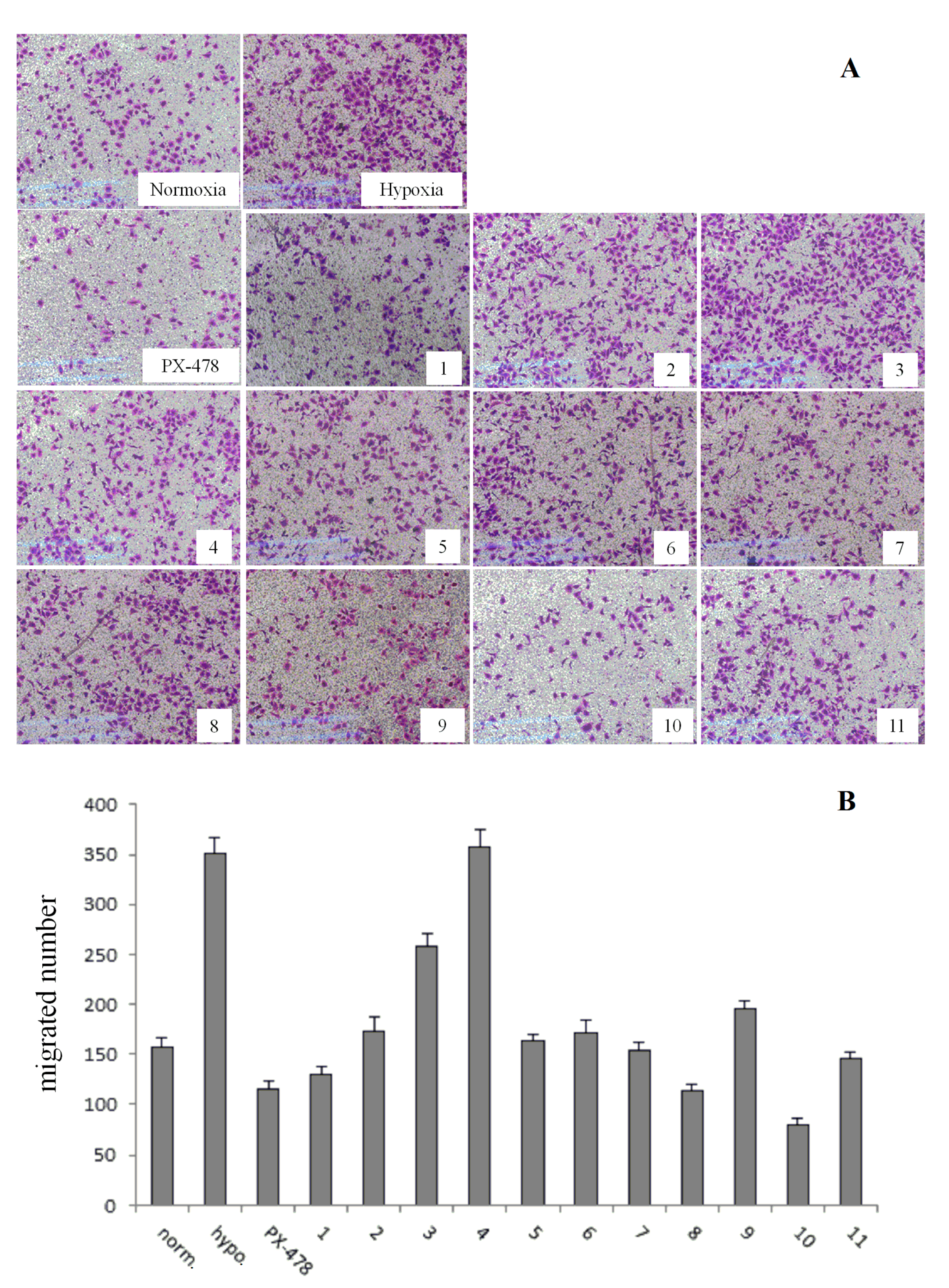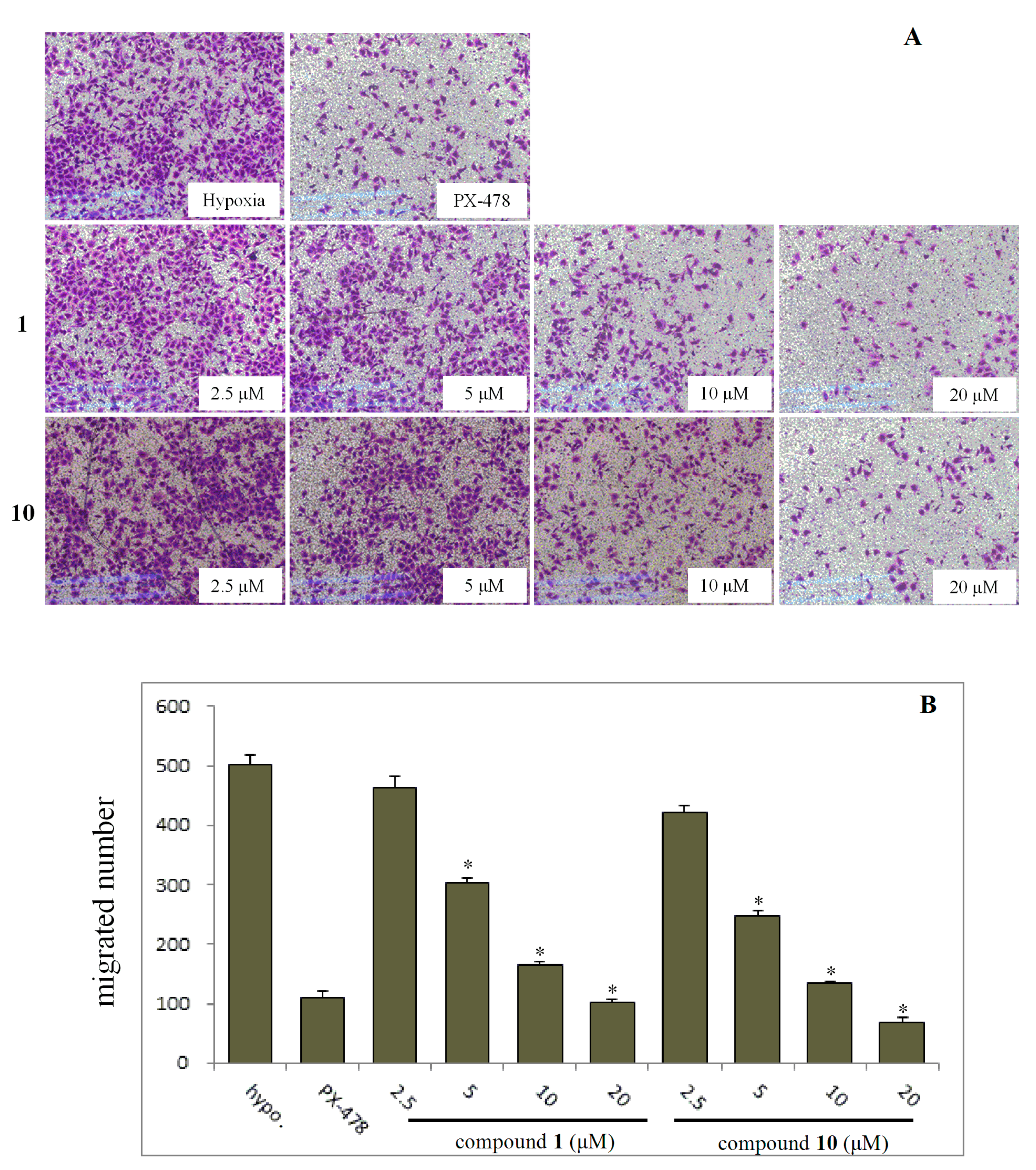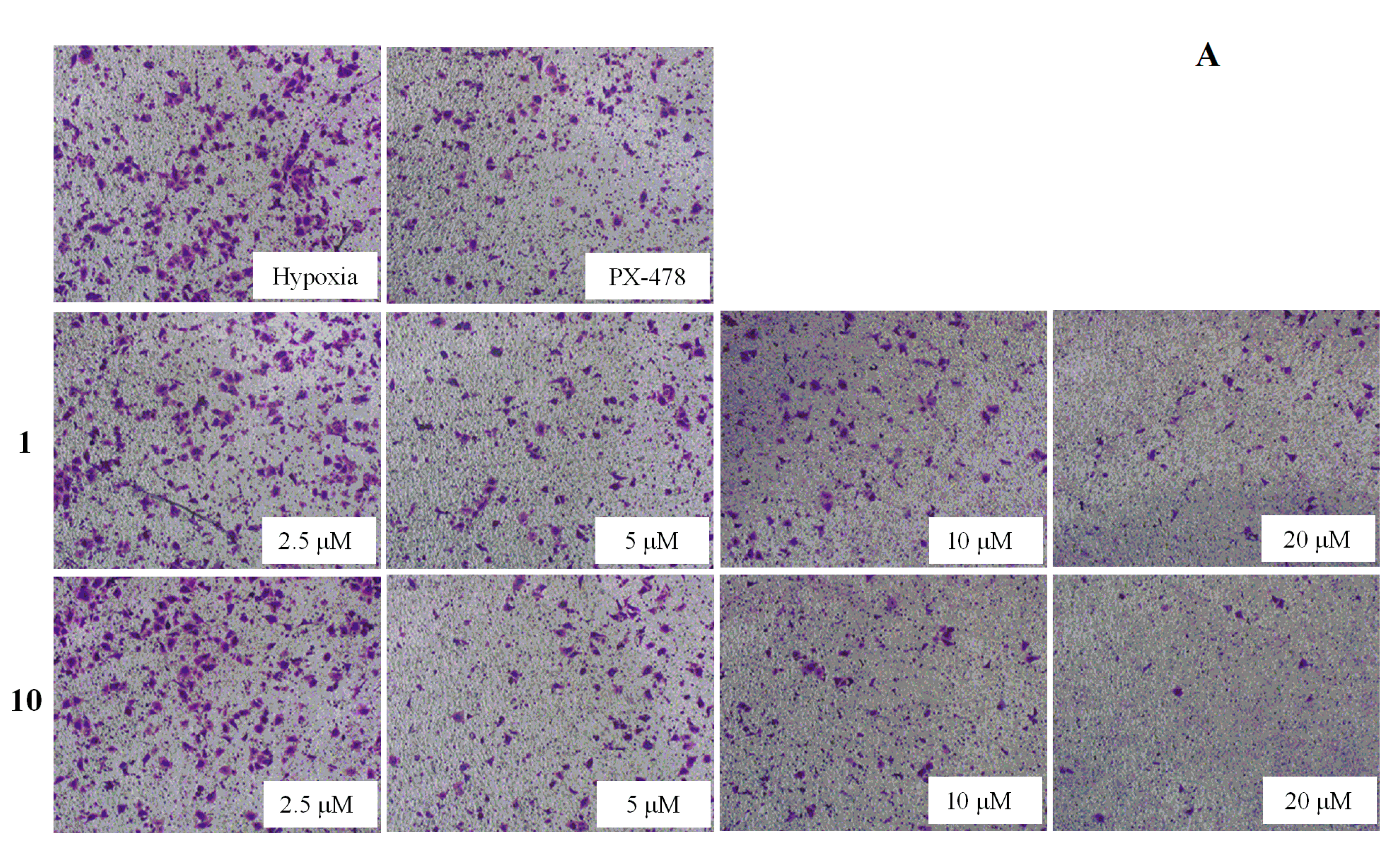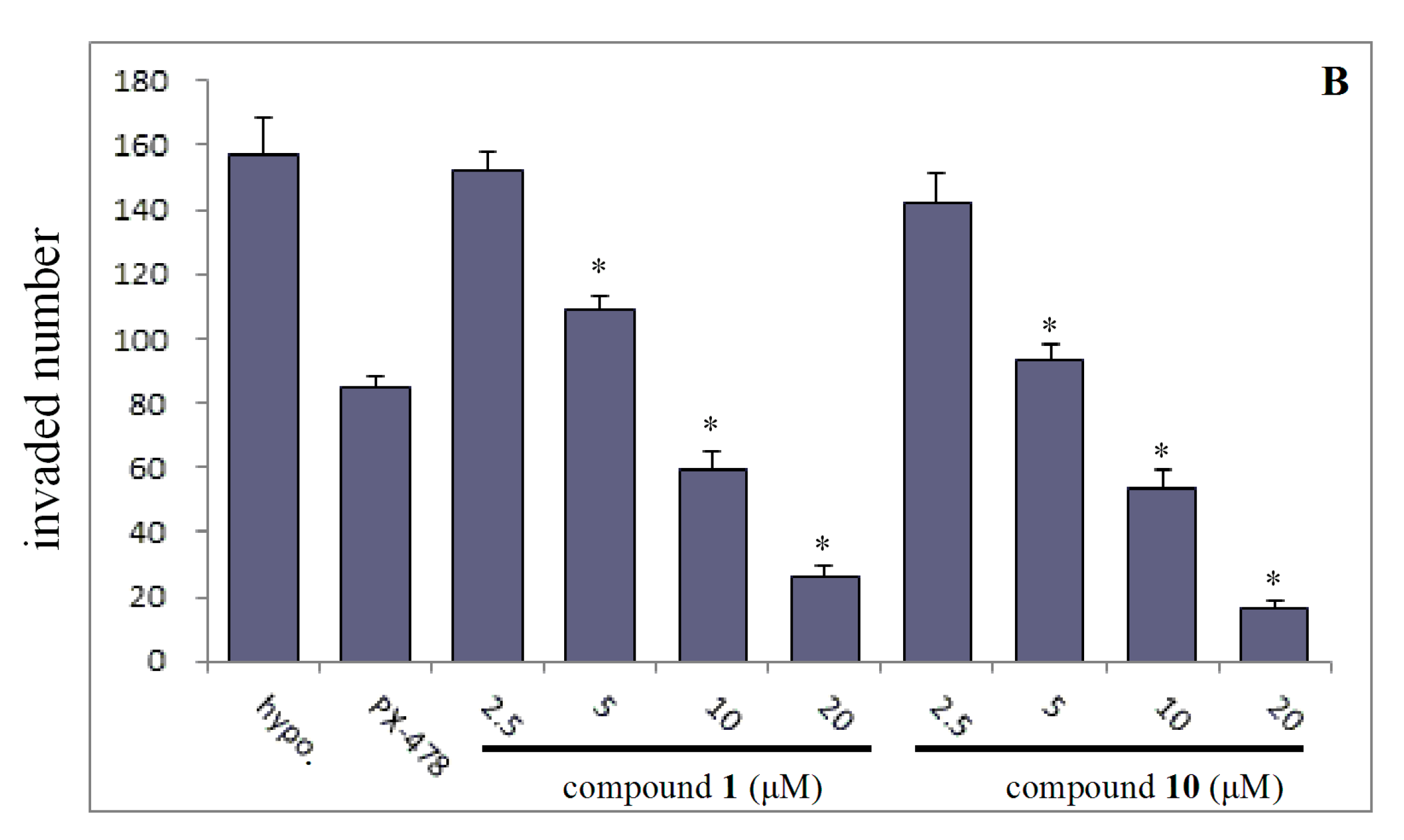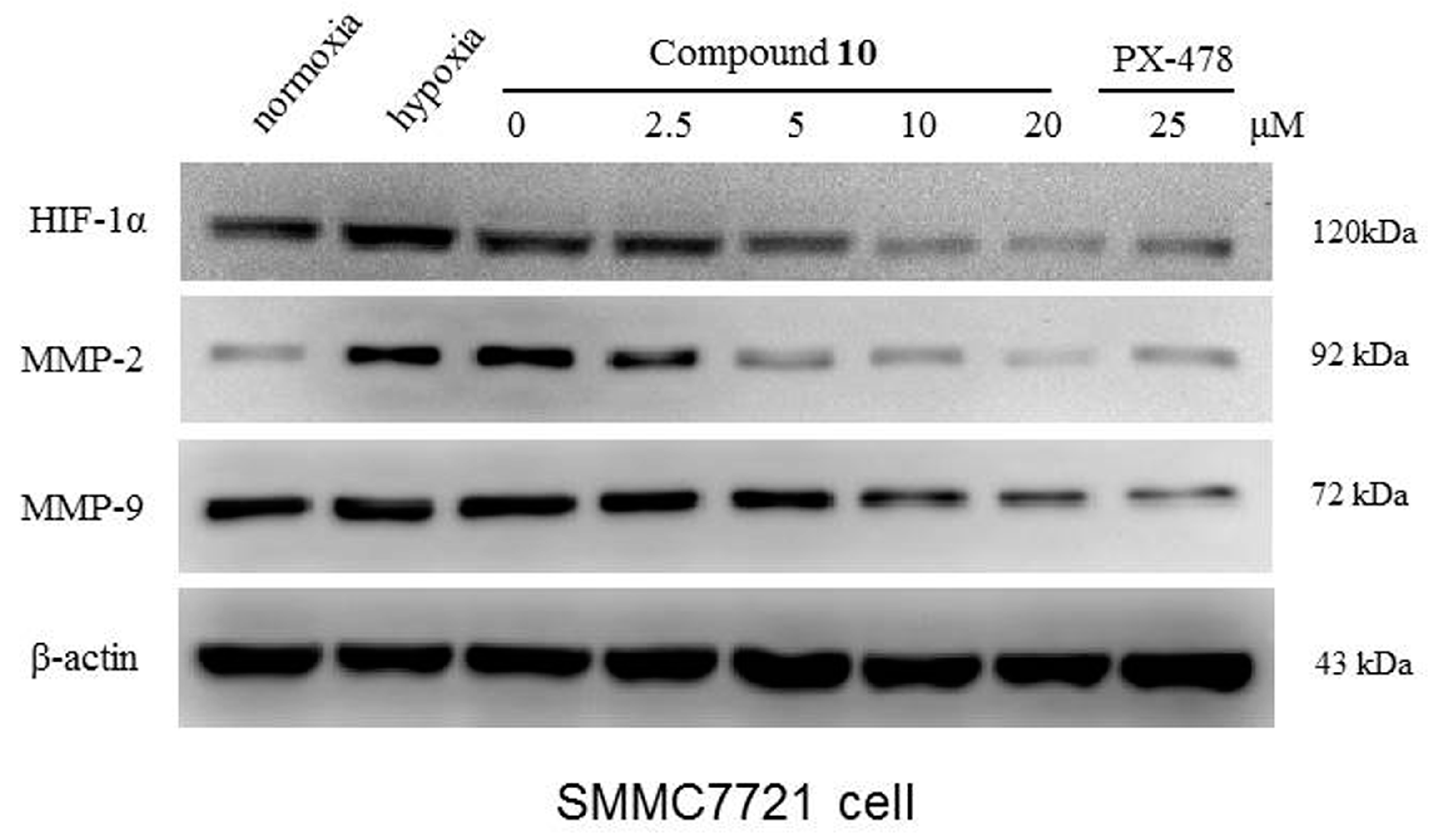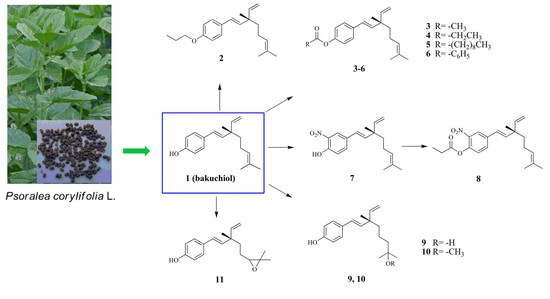3. Materials and Methods
3.1. General Information
All reagents used for chemical synthesis were purchased from Sigma-Aldrich (St. Louis, MO, USA). Solvents were distilled before use. All the reactions were monitored by TLC on silica gel F254 plates (Qingdao Haiyang Inc., Qingdao, China) for detection of the spot. Silica-gel column chromatography was performed for purification of the products. All NMR spectra were recorded on a DPX 600 instrument (Bruker, Fallanden, Switzerland) using CDCl3 as the solvent with TMS as the internal standard. Chemical shifts are expressed in delta (δ) units and coupling constants in Hz. The chemical shifts are reported in parts per million (ppm) and the following abbreviations are used: singlet (s), doublet (d), triplet (t), quartet (q), multiplet (m), and doublet of doublets (dd). Mass spectra were recorded on an ESI-Esquire 3000 instrument (Bruker Daltonics Inc., Billerica, MA, USA). The purity of all compounds (bakuchiol and its derivatives) was determined by HPLC (Shimadzu Co., Tokyo, Japan) and found to be in the 95–99% range.
3.2. Isolation of Bakuchiol (1)
The crude extract of bakuchiol was isolated from the seeds of
P. corylifolia L. Then the bakuchiol (
S,
E)-4-(3,7-dimethyl-3-vinylocta-1,6-dien-1- yl)phenol,
1, purity > 95%), was purified by silica gel column chromatography and characterized by spectroscopic and chemical methods [
15]. R
f = 0.45 (
n-hexane: ethyl acetate = 10:1).
3.3. Synthesis of (S,E)-1-(3,7-dimethyl-3-vinylocta-1,6-dien-1-yl)-4-propoxybenzene (2)
A mixture of bakuchiol (1, 256 mg, 1 mmol) and potassium carbonate (276 mg, 2 mmol) in acetone (5 mL) was stirred at reflux temperature for 1 h. Then bromopropane (185 mg, 1.5 mmol) was added, and the mixture was refluxed for another 5 h approximately. After cooling to the room temperature and removing the solution, the reaction was poured in some water and stirred for 0.5 h to wash away the remaining potassium carbonate. Then the solid was obtained by filtered and purified by silica gel column chromatography with 50:1 n-hexane:ethyl acetate mixture to obtain compound 2. The yield was 52.0%. Rf = 0.85 (n-hexane: ethyl acetate = 10:1). 1H-NMR (CDCl3) δ 7.27 (d, J = 8.0 Hz, 2H, Ar-H), 6.82 (d, J = 8.3 Hz, 2H, Ar-H), 6.25 (d, J = 15.9 Hz, 1H, 1-ene-H), 6.04 (d, J = 16.3 Hz, 1H, 2-ene-H), 5.87 (dd, J = 17.4, 10.7 Hz, 1H, 3-ethenyl-H), 5.10 (t, J = 6.4 Hz, 1H, 6-ene-H), 5.05–4.95 (m, 2H, 3-ethenyl-2H), 3.90 (t, J = 6.4 Hz, 2H, -OCH2-), 2.00–1.88 (m, 2H, -CH2-), 1.79 (dd, J = 13.9, 6.9 Hz, 2H, -CH2-), 1.66 (s, 3H, -CH3), 1.57 (s, 3H, -CH3), 1.52–1.43 (m, 2H, -CH2-), 1.18 (s, 3H, 3-CH3), 1.02 (t, J = 7.2 Hz, 3H, -CH3). 13C-NMR (CDCl3) δ 158.3, 146.1, 135.7, 131.3, 130.5, 127.1 (2C), 126.6, 124.9, 114.6 (2C), 111.8, 69.6, 42.5, 41.3, 25.7, 23.4, 23.3, 22.6, 17.6, 10.5. ESI-MS: m/z, [M + H]+ 299.2.
3.4. General Procedure for the Synthesis of (S,E)-4-(3,7-dimethyl-3-vinylocta-1,6-dien-1-yl) Phenyl Substituted Carboxylic Esters 3–6
Compounds 3–6 were synthesized from compound 1 with an appropriate alkanoic anhydride or acyl chloride in the presence of a catalytic amount of N,N-dimethylaminopyridine with 5 mL dichloromethane (DCM) as solvent. Reactions were monitored by TLC. After the reaction was complete, the mixture was poured in ice water and the resulting oily material, which was water insoluble, was separated and dissolved in DCM. Then the organic layer was washed with water for twice, then dried by anhydrous calcium chloride and concentrated under reduced pressure. The acyl derivatives were purified by silica gel column chromatography with a 40:1 n-hexane:ethyl acetate mixture as eluent to give compounds 3–6. The yields, Rf (n-hexane:ethyl acetate = 10:1) and the spectral data of compounds 3–6 are given below.
(S,E)-4-(3,7-dimethyl-3-vinylocta-1,6-dien-1-yl)phenyl acetate (3). The yield was 90.6%. Rf = 0.70. 1H-NMR (CDCl3) δ 7.38–7.32 (m, 2H, Ar-H), 7.04–6.99 (m, 2H, Ar-H), 6.30 (d, J = 16.2 Hz, 1H, 1-ene-H), 6.16 (d, J = 16.2 Hz, 1H, 2-ene-H), 5.87 (dd, J = 17.5, 10.7 Hz, 1H, 3-ethenyl-H), 5.10 (dd, J = 7.8, 6.4 Hz, 1H, 6-ene-H), 5.03 (ddd, J = 18.7, 14.1, 1.2 Hz, 2H, 3-ethenyl-2H), 2.29 (s, 3H, -COCH3), 1.95 (dd, J = 16.2, 7.7 Hz, 2H, -CH2-), 1.67 (s, 3H, -CH3), 1.58 (s, 3H, -CH3), 1.53–1.46 (m, 2H, -CH2-), 1.20 (s, 3H, 3-CH3). 13C-NMR (CDCl3) δ 169.5, 149.6, 145.7, 138.2, 135.8, 131.4, 127.0 (2C), 126.3, 124.7, 121.6 (2C), 112.1, 42.7, 41.2, 25.7, 23.3, 23.2, 21.1, 17.7. ESI-MS: m/z, [M + H]+ 299.2.
(S,E)-4-(3,7-dimethyl-3-vinylocta-1,6-dien-1-yl)phenyl propionate (4). The yield was 61.5%. Rf = 0.77. 1H-NMR (CDCl3) δ 7.35 (d, J = 8.6 Hz, 2H, Ar-H), 7.05–6.97 (m, 2H, Ar-H), 6.30 (d, J = 16.3 Hz, 1H, 1-ene-H), 6.15 (d, J = 16.3 Hz, 1H, 2-ene-H), 5.88 (dd, J = 17.5, 10.7 Hz, 1H, 3-ethenyl-H), 5.10 (t, J = 7.1 Hz, 1H, 6-ene-H), 5.03 (ddd, J = 18.7, 14.1, 1.2 Hz, 2H, 3-ethenyl-2H), 2.58 (q, J = 7.5 Hz, 2H, -CH2-), 1.95 (d, J = 8.3 Hz, 2H, -CH2-), 1.67 (s, 3H, -CH3), 1.58 (s, 3H, -CH3), 1.52–1.47 (m, 2H, -CH2-), 1.26 (t, J = 7.6 Hz, 3H, -CH3), 1.20 (s, 3H, 3-CH3). ESI-MS: m/z, [M + H]+ 313.2.
(S,E)-4-(3,7-dimethyl-3-vinylocta-1,6-dien-1-yl)phenyl decanoate (5). The yield was 11.7%. Rf = 0.80. 1H-NMR (CDCl3) δ 7.41–7.37 (m, 2H, Ar-H), 7.06–7.02 (m, 2H, Ar-H), 6.34 (d, J = 16.2 Hz, 1H, 1-ene-H), 6.19 (d, J = 16.2 Hz, 1H, 2-ene-H), 5.92 (dd, J = 17.5, 10.7 Hz, 1H, 3-ethenyl-H), 5.15 (td, J = 7.1, 3.6 Hz, 1H, 6-ene-H), 5.07 (ddd, J = 18.8, 14.1, 1.3 Hz, 2H, 3-ethenyl-2H), 2.58–2.55 (m, 2H, -CH2-), 1.99 (dd, J = 16.2, 7.6 Hz, 2H, -CH2-), 1.79–1.76 (m, 2H, -CH2-), 1.71 (s, 3H, -CH3), 1.62 (s, 3H, -CH3), 1.46–1.40 (m, 4H, -(CH2)2-), 1.35–1.31 (m, 10H, -(CH2)5-), 1.24 (s, 3H, 3-CH3), 0.93–0.92 (m, 3H, -CH3). 13C-NMR (CDCl3) δ 172.2, 149.9, 145.7, 138.2, 135.7, 131.2, 127.0 (2C), 126.4, 124.9, 121.7 (2C), 112.2, 42.7, 41.4, 34.4, 32.0, 29.9, 29.7, 29.6, 29.5, 29.3, 25.7, 25.1, 23.3, 22.8, 17.6, 14.2. ESI-MS: m/z, [M + H]+ 411.3.
(S,E)-4-(3,7-dimethyl-3-vinylocta-1,6-dien-1-yl)phenyl benzoate (6). The yield was 13.9%. Rf = 0.70. 1H-NMR (CDCl3) δ 8.20 (dd, J = 8.3, 1.2 Hz, 2H, ph-H), 7.65–7.61 (m, 1H, ph-H), 7.51 (t, J = 7.8 Hz, 2H, ph-H), 7.41 (d, J = 8.5 Hz, 2H, Ar-H), 7.15 (d, J = 8.6 Hz, 2H, Ar-H), 6.34 (d, J = 16.3 Hz, 1H, 1-ene-H), 6.19 (d, J = 16.3 Hz, 1H, 2-ene-H), 5.89 (dd, J = 17.5, 10.7 Hz, 1H, 3-ethenyl-H), 5.12 (t, J = 7.2 Hz, 1H, 6-ene-H), 5.04 (ddd, J = 18.8, 14.1, 1.3 Hz, 2H, 3-ethenyl-2H), 1.97 (dd, J = 16.2, 7.4 Hz, 2H, -CH2-), 1.68 (s, 3H, -CH3), 1.59 (s, 3H, -CH3), 1.52 (dd, J = 9.6, 7.8 Hz, 2H, -CH2-), 1.22 (s, 3H, 3-CH3). 13C-NMR (CDCl3) δ 165.2, 149.8, 145.7, 138.3, 135.8, 133.6, 131.4, 130.2 (2C), 129.6, 128.6(2C), 127.1 (2C), 126.4, 124.7, 121.7 (2C), 112.1, 42.7, 41.3, 25.7, 23.3, 23.3, 17.7. Its HR-ESI-MS exhibited a pseudo molecular ion peak at m/z 361.2162 [M + H]+ consistent with the molecular formula C25H28O2.
3.5. Synthesis of (S,E)-4-(3,7-dimethyl-3-vinylocta-1,6-dien-1-yl)-2-nitrophenol (7)
Compound 1 (0.5 mM) was dissolved in acetone (10 mL), then nickel (II) nitrate (1 mmol) and a catalytic amount of p-TSA (0.01 mmol) were added. The mixture was refluxed until compound 1 was fully consumed, and then the acetone was removed under vacuum to get the crude product. After extraction with water and DCM, the organic layer was dried with anhydrous calcium chloride overnight and concentrated under reduced pressure. The pure compound 7 was obtained by silica gel column chromatography with n-hexane:ethyl acetate mixture (40:1) as eluent. The yield of compound 7 was 51.8%. Rf = 0.85 (n-hexane:ethyl acetate = 10:1). 1H-NMR (CDCl3) δ 10.52 (s, 1H, Ar-OH), 8.04 (s, 1H, Ar-H), 7.61 (dd, J = 8.3, 1.7 Hz, 1H, Ar-H), 7.10 (d, J = 8.7 Hz, 1H, Ar-H), 6.26 (d, J = 15.8 Hz, 1H, 1-ene-H), 6.17 (d, J = 16.3 Hz, 1H, 2-ene-H), 5.87 (dd, J = 17.4, 10.6 Hz, 1H, 3-ethenyl-H), 5.15–5.09 (m, 1H, 6-ene-H), 5.10–4.98 (m, 2H, 3-ethenyl-2H), 1.95 (dd, J = 16.4, 8.7 Hz, 2H, -CH2-), 1.68 (s, 3H, -CH3), 1.58 (s, 3H, -CH3), 1.53 - 1.47 (m, 2H, -CH2-), 1.21 (s, 3H, -CH3). ESI-MS: m/z, [M + H]+ 302.3.
3.6. Synthesis of (S,E)-4-(3,7-dimethyl-3-vinylocta-1,6-dien-1-yl)-2-nitrophenyl Propionate (8)
Using the preparation and purification described above for compound 4, and using 7, propionic anhydride and catalytic amount of N,N-dimethylaminopyridine in 5 mL DCM as solvent, compound 8 was prepared in 67.2% yield. Rf = 0.50 (n-hexane:ethyl acetate = 20:1). 1H-NMR (CDCl3) δ 8.04 (d, J = 2.1 Hz, 1H, Ar-H), 7.59 (dd, J = 8.4, 2.1 Hz, 1H, Ar-H), 7.15 (d, J = 8.4 Hz, 1H, Ar-H), 6.30 (q, J = 16.2 Hz, 2H, 1-ene-2H), 5.87 (dd, J = 17.5, 10.7 Hz, 1H, 3-ethenyl-H), 5.09 (dt, J = 6.0, 4.8 Hz, 2H, 3-ethenyl-H and 6-ene-H), 5.03 (dd, J = 17.5, 1.1 Hz, 1H, 3-ethenyl-H), 2.67 (q, J = 7.5 Hz, 2H, -CH2-), 1.98 - 1.92 (m, 2H, -CH2-), 1.68 (s, 3H, -CH3), 1.58 (s, 3H, -CH3), 1.52 (ddd, J = 8.3, 5.2, 1.7 Hz, 2H, -CH2-), 1.29 (t, J = 7.5 Hz, 3H, -CH3), 1.22 (s, 3H, -CH3). 13C-NMR (CDCl3) δ 172.2, 144.9, 142.6, 141.8, 141.5, 137.1, 131.8, 131.6, 125.2, 124.5, 122.8, 112.8, 42.9, 41.1, 27.5, 25.7, 23.2, 23.1, 17.8, 8.7. Its HR-ESI-MS exhibited a pseudo molecular ion peak at m/z 358.2013 [M + H]+ consistent with the molecular formula C21H27NO4.
3.7. Synthesis of (S,E)-4-(7-hydroxy-3,7-dimethyl-3-vinyloct-1-en-1-yl)phenol (9) and (S,E)-4-(7-methoxy-3,7-dimethyl-3-vinyloct-1-en-1-yl)phenol (10)
Compound 1 (0.5 mM, Rf = 0.70, DCM:methanol = 50:1) was dissolved in 5 mL methanol, and dilute sulphuric acid (1 mL, 3 M) was slowly added with ice bath cooling. Then the temperature was raised up to 45 °C and the mixture was stirred for 8 h until the reaction was complete (monitored by TLC). After the methanol was removed under reduced pressure, the solid residue was extracted with 250 mL water and the same volume of DCM. Then the organic layer was washed with water, dried over anhydrous sodium sulfate overnight, and concentrated under reduced pressure. The residue was then purified by column chromatography on silica gel, using DCM and methanol mixture (80:1) as eluent, to give compounds 9 and 10.
(S,E)-4-(7-hydroxy-3,7-dimethyl-3-vinyloct-1-en-1-yl)phenol (9). The yield was 16.4%. Rf = 0.20 (DCM: methanol = 50:1). 1H-NMR (CDCl3) δ 7.26–7.24 (m, 1H, Ar-H), 7.24–7.23 (m, 1H, Ar-H), 7.10 (s, 1H), 6.77–6.76 (m, 1H, Ar-H), 6.75–6.74 (m, 1H, Ar-H), 6.24 (d, J = 16.2 Hz, 1H, 1-ene-H), 6.05 (d, J = 16.2 Hz, 1H, 2-ene-H), 5.87 (dd, J = 17.5, 10.7 Hz, 1H, 3-ethenyl-H), 5.02 (ddd, J = 18.9, 14.1, 1.3 Hz, 2H, 3-ethenyl-H), 1.48–1.44 (m, 4H, -CH2-), 1.37–1.33 (m, 2H, -CH2-), 1.26 (s, 1H, Ar-OH), 1.20 (s, 6H, 7-CH3 and 8-CH3), 1.19 (s, 3H, 3-CH3). 13C-NMR (CDCl3) δ 154.9, 146.0, 135.8, 127.4 (2C), 126.6, 116.0, 115.4 (2C), 111.9, 71.4, 44.6, 42.6, 41.9, 29.3 (2C), 23.5, 19.3. ESI-MS: m/z, [M − H]+ 273.2.
(S,E)-4-(7-methoxy-3,7-dimethyl-3-vinyloct-1-en-1-yl)phenol (10). The yield was 20.0%. Rf = 0.40 (DCM: methanol = 50:1). 1H-NMR (CDCl3) δ 7.25–7.24 (m, 1H, Ar-H), 7.24–7.23 (m, 1H, Ar-H), 6.78–6.76 (m, 1H, Ar-H), 6.76–6.75 (m, 1H, Ar-H), 6.24 (d, J = 16.2 Hz, 1H, 1-ene-H), 6.05 (d, J = 16.2 Hz, 1H, 2-ene-H), 5.87 (dd, J = 17.5, 10.7 Hz, 1H, 3-ethenyl-H), 5.04–4.98 (m, 2H, 3-ethenyl-2H), 3.16 (s, 3H, -OCH3), 1.47–1.41 (m, 4H, -CH2-), 1.34–1.28 (m, 2H, -CH2-), 1.18 (s, 3H, 3-CH3), 1.13 (s, 6H, -CH3). 13C-NMR (CDCl3) δ 155.0, 146.1, 135.8, 130.6, 127.4 (2C), 126.6, 115.4 (2C), 111.9, 75.0, 49.1, 42.6, 42.0, 40.5, 25.0 (2C), 23.5, 18.8. Its HR-ESI-MS exhibited a pseudo molecular ion peak at m/z 289.2139 [M + H]+ consistent with the molecular formula C19H28O2.
3.8. Synthesis of 4-((3S,E)-3-(2-(3,3-dimethyloxiran-2-yl)ethyl)-3-methylpenta-1,4-dien-1-yl) phenol (11)
Compound 1 (1.5 mmol) was dissolved in DCM (6 mL). 3-Chloroperoxybenzoic acid (m-CPBA, 3 mmol) dissolved in 5 mL DCM was added dropwise to the solution under ice bath cooling, and then the mixture was stirred at room temperature for 4.5 h, until the reaction was complete as monitored by TLC. Saturated sodium bicarbonate was added and stirred for 1 h to neutralize the excess m-CPBA. After pouring into 250 mL water, the aqueous layer was extracted thrice with 90 mL dichloromethane (30 mL × 3). The combined dichloromethane layers were dried over anhydrous sodium sulfate overnight. Evaporation of the solvent gave a crude product, which was purified by silica gel column chromatography with n-hexane:ethyl acetate mixture (10:1) as eluent to give the title compound in 27.4% yield. Rf = 0.30 (n-hexane:ethyl acetate mixture = 10:1). 1H-NMR (CDCl3) δ 7.25–7.24 (m, 1H, Ar-H), 7.24–7.23 (m, 1H, Ar-H), 6.78–6.77 (m, 1H, Ar-H), 6.76–6.75 (m, 1H, Ar-H), 6.28–6.24 (m, 1H, 1-ene-H), 6.07–6.01 (m, 1H, 2-ene-H), 5.89–5.83 (m, 1H, 3-ethenyl-H), 5.07–5.02 (m, 2H, 3-ethenyl-2H), 2.71 (t, J = 5.7 Hz, 1H, 3′-CH-), 1.58–1.54 (m, 6H, -CH3), 1.31–1.28 (m, 2H, -CH2-), 1.26–1.24 (m, 2H, -CH2-), 1.20 (s, 3H, -CH3). 13C-NMR (CDCl3) δ 154.8, 145.5, 135.2, 129.8, 127.4 (2C), 126.9, 115.4 (2C), 112.2, 64.7, 58.5, 42.2, 37.5, 24.9, 24.2, 23.4, 18.7. ESI-MS: m/z, [M + H]+ 273.2.
3.9. Cell Culture, Growth Conditions, and Treatments
SMMC7721 (human liver carcinoma cells), HepG2 (human liver hepatocellular carcinoma cells) and SW480 (human colorectal carcinoma cells) were cultured in Dulbecco’s modified Eagle’s medium (DMEM), which was obtained from Gibco (Grand Island, NY, USA). MDA-MB-231 cells (human breast cancer cells) were cultured in minimum essential medium (MEM, Gibco, Grand Island, NY, USA) supplemented with 10% fetal bovine serum (FBS, Millipore, Billerica, MA, USA) and maintained at 37 °C in a humidified incubator with 5% CO2. All four types of cancer cells were obtained from the Shanghai Cell Bank of the Chinese Academy of Sciences (CAS). To establish hypoxic conditions, the culture medium was supplemented with 150 μM CoCl2 for 24 h. The compounds were dissolved in dimethyl sulfoxide (DMSO, BIOSHARP, Hefei, China). PX-478 (Selleck Chemicals, Houston, TX, USA), a selective HIF-1α inhibitor, was dissolved in ddH2O. The control group was treated with DMSO only under identical conditions.
3.10. MTT Assay
Cells were seeded in 96-well microtiter plates at a density of 5 × 103 cells per well and treated with different concentrations of the compounds and adriamycin for 48 h. At the end of the incubation period, 15 μL of MTT (purchased from Sigma, St. Louis, MO, USA), at a dose of 5 mg/mL in phosphate-buffered saline (PBS), was added to each well and incubated at 37 °C for 4 h. After 4 h, the MTT solution was replaced with 150 μL of DMSO to dissolve the formazan crystals. The plates were further incubated for 30 min, and the cell viability was determined by measuring absorbance at a test wavelength of 490 nm with the microplate reader (Synergy HT, BioTek, Winooski, VT, USA).
3.11. Cell Migration Assay
The migration assay, which was used to screen the active compounds from the target products, was performed using a 24-well cell culture plate with 8.0 μm pore size membrane inserts without matrigel. First, 5 × 104 SMMC7721 cells were added to the upper wells, and the chambers were incubated for 24 h at 37 °C. The lower chamber was filled with 800 μL of 10% FBS as a chemoattractant. After 24 h under normoxic conditions, the cells that had migrated were stained (Crystal Violet) and photographed under a light microscope at 200× magnification. The number of migratory cells was then counted and analyzed to determine statistically significant differences. Each condition was assayed in triplicate, the experiments were performed independently at least three times, and the results were expressed as the number of cells/field. One-way analysis of variance was used to determine significant differences. The assay described here was also used to determine the influence of the compounds 1 and 10 at different concentrations on the migration of SMMC7721 cells.
3.12. Cell Invasion Assay
The invasion assay was performed using a 24-well cell culture plate with 8.0 μm pore size membrane inserts. The membrane undersurface was coated with 50 μL of matrigel with serum-free medium for 30 min at 37 °C. The rest of the operational steps and the conditions of the invasion assay were the same as those described for the cell migration assay.
3.13. Western Blotting
The SMMC7721 cells were plated in a 6-well culture plate at a density of 5 × 105 cells per well. After incubation with drugs, the cells were lysed with SDS buffer containing 200 mM Tris (pH 6.8), 40% glycerol, and 10% mercaptoethanol. The protein (30 μg) obtained from cell extracts was separated using 10–15% SDS/polyacrylamide gel electrophoresis, and then transferred to a polyvinylidene difluoride (PVDF) membrane. Membranes were blocked with 10% skimmed milk in Tris-buffered saline containing 0.1% Tween-20 (TBST) for 1 h at room temperature, and then incubated overnight at 4 °C with respective primary antibodies [anti-HIF-1α (Epitomics, Burlingame, CA, USA), anti-MMP-2 (Santa Cruz Biotechnology Inc., Santa Cruz, CA, USA), anti-MMP-9 (Santa Cruz Biotechnology Inc., Santa Cruz, CA, USA), and anti-β-actin (Santa Cruz Biotechnology Inc., Santa Cruz, CA, USA)] diluted to 1:1000–2000 in TBST containing 5% skimmed milk. After washing three times with TBST, the membranes were incubated with horseradish peroxidase- conjugated anti-rabbit and anti-mouse serum, which were used as secondary antibodies (diluted 1:10,000 in TBST containing 5% skimmed milk) for 1 h at room temperature. After incubation, the antigen–antibody complexes were visualized using the ECL kit and β-actin was analyzed as a loading control.
3.14. Statistical Analysis
All experiments were repeated three times. Results are expressed as the mean ± standard deviation. Differences were evaluated using one-way analysis of variance with the least significant difference post hoc test for multiple comparisons via SPSS (version 17.0, SPSS Inc., Chicago, IL, USA). p < 0.05 was considered to indicate a statistically significant difference.

